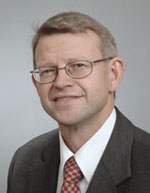Sweden’s super lab is strengthened
The national cooperation between KTH, Uppsala University and Chalmers in the form of the clean-room network Myfab is to be upgraded and will become a national resource. This is something the Science Council has arranged. Increased access to the laboratories in question for all of Sweden’s researchers is an important aspect of the improved cooperation.

“With Myfab and these three laboratories, we can continue to be the best in Europe, in particular as regards laboratory equipment. Nobody can beat us,” says Mikael Östling. He is Director of education at the ICT school where the Electrum laboratory forms a part of KTH’s Myfab.
The initiative is of the greatest importance because it means that Sweden can keep up with the competition with other international clean-room laboratories. According to Mikael Östling, Myfab facilitates research which would not otherwise be carried out unless the cooperation was available.
With Myfab becoming a national resource, it means that NFL at Chalmers, Ångström MSLlab at Uppsala University and the Elecktrum laboratory at KTH will be available to all researchers in Sweden. In addition, so-called user support is included, researchers will be able to gain free access to any help they may require when using the equipment.
So far, Myfab has been a success, and that is the reason why continued support from The Science Council is being provided.
“Throughout the years, we have learned how we should cooperate. It means, among other things, providing each other with backup as regards laboratory equipment in case it breaks down, but it also means the provision of feedback as to the type of equipment that should be purchased so that new equipment can be a compliment to the existing equipment rather than each laboratory purchasing similar equipment,” says Mikael Östling.
He adds that Myfab is a pure form of cooperation, not a product on paper. In addition, KTH, Uppsala University and Chalmers have succeeded with the objectives that were set four years ago, among other things, to get more start-up companies in the clean-rooms.
Many noteworthy results have also been achieved through Myfab. At KTH’s Electrum laboratory, leading-edge technologies have been developed for both medical sensor application and energy-efficient components for electric drive systems. In addition, researchers have developed a process which simplifies manufacturing in the semiconductor industry.
Chalmers has equipped the Herschel telescope with a small superconducting component which is highly sensitive and which can detect extremely weak signals from hidden material in the universe. In the clean-room at the Ångström laboratory in Uppsala, an algae battery has been developed.
For more information, contact Mikael Östling at 08 - 790 43 01 or ostling@kth.se.
Peter Larsson

